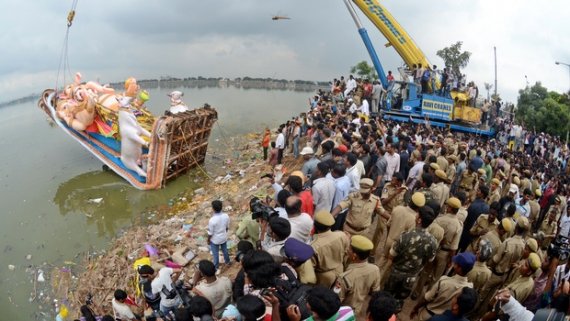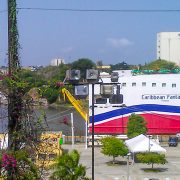Ganesh Chaturthi
By Maritza Lee, MURP ’16 & International Practice Pathway Fellow
The day to go home has arrived. On my way to the airport, I reflected over the last weeks in Hyderabad. Throughout my internship at SaciWATERS I researched water access policies in peri-urban areas. The lack of adequate access to water is particularly problematic in peri-urban settlements. The rapid growth of cities is spurring development on rural land, which leads to these peri-urban settlements. Some of these areas have been incorporated into cities but remain left behind in terms of public service provisions, including water services. In India, neither public utilities nor large-scale private companies are addressing the water needs of peri-urban areas. Rather, informal water distribution systems have become the norm. Due to these informal systems, peri-urban populations are left with no choice but to pay market prices for water, which are considerable higher than prices paid by the population with access to the formal water network. As a result, the poor peri-urban developments end up paying more for drinkable water than anybody else in the country. Through my internship, I have become aware of this huge water accessibility issue in India.
It is my last day here and it will take an hour-long car trip to get to the airport; this long trip will allow me to observe Hyderabad’s busy streets one more time. During the trip, something grabbed my attention. We drove by several trucks transporting huge statues of the god Ganesha into the city. The statues were at least five feet tall; they were painted with bright colors and elaborate flowers. Once at the airport, I meet a young Indian master’s student who was also taking a plane to the Mumbai airport. After a few minutes of conversation, I asked her about the statues. She smiled and said: “You will miss one of the major festivals celebrating Ganesha. Tomorrow most streets will shut down and you would not have been able to make it to the airport. Millions of people will be singing and dancing on the streets. Several parades will carry hundreds of statues of Ganesha that are up to 24 feet tall towards the Hussain Sagar Lake. Then, they will sink the statues. This happens every year around India.”
I was shocked. Through my summer internship, I learned that Hussain Sagar Lake was built in 1562 on a tributary of the River Musi, in response to the increasing water and irrigation demand by residents. In the last decades, the lake’s water quality had been getting worse due to pollution. Why then would these statues be sunk into the river? I left India without a clear answer about how the Indian people can address water problems. Instead, I developed an additional question. How can planners and policymakers address water uses that cause pollution but are deeply embedded in the cultural fabric of the country? Through this festival, I learned that cultural uses of water are determinants of water quality as well. While I do not have any answers, learning about this water issue is a first step.
In closing, I would like to thank the Bergmans who made this unique professional and personal experience possible. I would also thank my patient husband and daughter for supporting me through this experience. Finally, thank Professor Commins, Jenny and Rosana for your invaluable help and support that made this experience wonderful!
Photo Credits: IndiaTVNews.com












Leave a Reply
Want to join the discussion?Feel free to contribute!